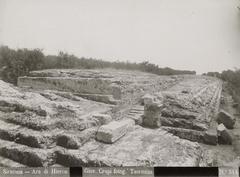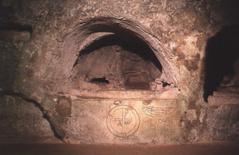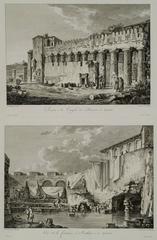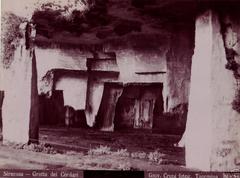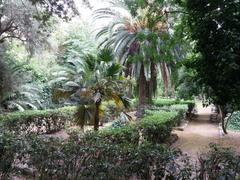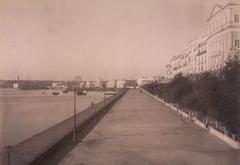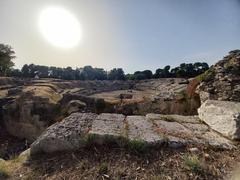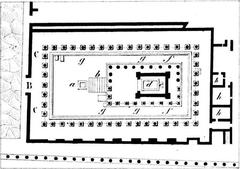Guide to Visiting Ex Chiesa di Santa Panagia, Syracuse, Italy
Date: 24/07/2024
Introduction
The Ex Chiesa di Santa Panagia in Syracuse, Italy, is more than just a historical site; it is a testament to the rich tapestry of cultural and architectural influences that have shaped Sicily over the centuries. This guide aims to provide an in-depth exploration of the Ex Chiesa di Santa Panagia, covering its origins, architectural evolution, and the various cultural transformations it has witnessed, from its early Christian roots to its Byzantine, Islamic, and Norman influences. Additionally, practical visitor information such as visiting hours, ticket prices, and travel tips are included to help you make the most of your visit. Whether you are a history enthusiast or a casual traveler, this guide will offer valuable insights into one of Syracuse’s most captivating historical monuments (CityMapSicilia, Tripmondo).
Table of Contents
- Introduction
- Origins and Early History
- Byzantine and Islamic Influence
- Norman Conquest and Re-Christianization
- Architectural Evolution
- The Earthquake of 1169
- Later Historical Developments
- Modern Era and Preservation Efforts
- Visitor Information
- Guided Tours and Special Events
- Photographic Spots
- FAQ
- Conclusion
Exploring Ex Chiesa di Santa Panagia - History, Visiting Hours, and Tips
Origins and Early History
The Ex Chiesa di Santa Panagia’s origins date back to the early Christian period, reflecting the religious and cultural transformations in the region over centuries. Initially, the site was used for early Christian worship, as evidenced by architectural remnants and historical records.
Byzantine and Islamic Influence
During the Byzantine era, Syracuse was a prominent center of Christianity, and many churches, including Santa Panagia, were established or repurposed. However, the Islamic conquest of Sicily in the 9th century brought significant changes. Many Christian sites, including Santa Panagia, were converted into mosques, leaving a lasting mark on the architecture and cultural landscape of Syracuse.
Norman Conquest and Re-Christianization
The Norman conquest of Syracuse in 1085 marked another pivotal chapter for Santa Panagia. The Normans, under Roger I, reclaimed the city from Islamic rule and initiated a process of re-Christianization. Byzantine churches that had been converted into mosques were restored to their original religious functions. Santa Panagia was re-consecrated as a Christian church (source).
Architectural Evolution
The architectural evolution of Santa Panagia showcases the various cultural influences that have shaped Syracuse. The church’s structure exhibits elements of Byzantine, Islamic, and Norman architectural styles. The use of pointed arches, a hallmark of Norman architecture introduced during the Swabian rule in Sicily, is particularly notable (source).
The Earthquake of 1169
The earthquake of 1169 significantly impacted many buildings in Syracuse, including Santa Panagia. The tremor caused extensive damage, necessitating substantial restoration efforts. These restorations often involved incorporating new architectural elements and reinforcing the buildings to withstand future seismic activity (source).
Later Historical Developments
In the centuries following the Norman period, Santa Panagia continued to serve as a religious site, adapting to the changing political and cultural landscape of Sicily. The church’s history is intertwined with the broader historical narrative of Syracuse, reflecting the city’s resilience and adaptability through periods of conquest, natural disasters, and cultural shifts.
Modern Era and Preservation Efforts
In the modern era, the Ex Chiesa di Santa Panagia has been the focus of preservation efforts aimed at safeguarding its historical and architectural heritage. These efforts are crucial in maintaining the integrity of the site and ensuring that future generations can appreciate its historical significance. The church is part of a broader initiative to preserve the cultural heritage of Syracuse, which includes other notable sites such as the Greek Theatre of Syracuse and the Ear of Dionysius (source).
Visitor Information
Visiting Hours
The Ex Chiesa di Santa Panagia is open to visitors year-round. Visiting hours may vary, so it’s advisable to check the official website or contact the local tourist information office for the most up-to-date information.
Tickets
Admission to the Ex Chiesa di Santa Panagia is typically free, but donations are encouraged to support ongoing preservation efforts. Special tours may have a nominal fee.
Travel Tips
- Getting There - The nearby Santa Panagia railway station provides easy access to the site. Local buses and taxis are also available.
- Best Time to Visit - Early mornings or late afternoons are the best times to visit to avoid crowds and enjoy the site in a more serene setting.
- Nearby Attractions - Consider visiting other historical sites in Syracuse, such as the Greek Theatre of Syracuse and the Ear of Dionysius, to make the most of your trip.
Guided Tours and Special Events
Guided tours are available for visitors who wish to gain deeper insights into the history and architecture of the Ex Chiesa di Santa Panagia. Special events, such as historical reenactments and cultural festivals, are occasionally held at the site. Check the official website or local event listings for more details.
Photographic Spots
The Ex Chiesa di Santa Panagia offers numerous spots perfect for photography. The combination of Byzantine, Islamic, and Norman architectural styles provides a unique backdrop for capturing the essence of Syracuse’s historical landscape.
FAQ
Q - What are the visiting hours for Ex Chiesa di Santa Panagia? A - Visiting hours may vary. Check the official website or local tourist information office for the most up-to-date information.
Q - Is there an admission fee for Ex Chiesa di Santa Panagia? A - Admission is typically free, but donations are encouraged to support preservation efforts. Some special tours may require a nominal fee.
Q - What is the best way to get to Ex Chiesa di Santa Panagia? A - The nearby Santa Panagia railway station provides easy access. Local buses and taxis are also available.
Q - Are guided tours available? A - Yes, guided tours are available and can provide deeper insights into the site’s history and architecture.
Conclusion
The Ex Chiesa di Santa Panagia stands as a monument to the dynamic history and cultural richness of Syracuse. From its early Christian beginnings through Byzantine and Islamic influences to its re-Christianization under Norman rule, the church encapsulates the resilience and adaptability of the region. Although currently under renovation, the ruins of this historical site continue to draw visitors, offering a glimpse into the architectural and cultural transformations that have shaped Sicily. Ongoing preservation efforts promise to restore the Ex Chiesa di Santa Panagia to its former glory, ensuring that it remains a vital part of Syracuse’s cultural heritage. Plan your visit today and immerse yourself in the rich history and cultural significance of this remarkable site (source, CityMapSicilia).
References
- Siracusa in età normanna (1085-1194), 2018, Academia.edu source url
- Tonnara di Santa Panagia, CityMapSicilia source url
- Santa Panagia, Tripmondo source url
